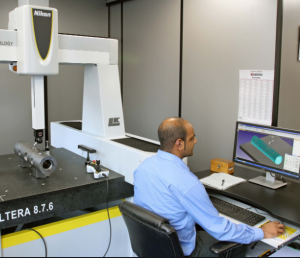(Akiit.com) A CMM stands for ‘coordinate measuring machine,’ referring to any kind of machine which measures objects using geometry, detecting surface points with the use of a probe. CMM’s use a variety of different probe types, including laser, optical, and mechanical. Coordinate measuring machines rely on a three axes coordinate system, much like those used to build 3D structures. If you operate within industries including manufacturing, engineering, technology, or science, you’ll likely make use of a CMM. There are various types of these machines, so it can be helpful to understand the differences before committing to purchasing CMMs or Metrology Parts.
Gantry CMM
Gantry CMMs are designed with a large bridge that is supported by raised pillars. These CMMs are much larger when compared with the other types available; for this reason, you’ll often find these in use within the field of aerospace. If you need to measure large components, with high levels of accuracy, a Gantry CMMS is an ideal choice. Gantry CMMs are not portable, and they are usually fairly expensive to build. With this in mind, if you require portability and are not measuring larger objects, it’s best to opt for another type.
Bridge CMM
A Bridge CMM is one of the most commonly used types of machine. These machines use a moving bridge to define values using the Z-axis; this is achieved with movements up and down the bridge across the base of the machine. The head of the machine calculates the X-axis values by moving from one side of the bridge to the other and back. The Y values are gained by crossing the whole bridge and the base. Like Gantry CMMs, you’ll achieve a high level of accuracy when using these machines to measure your components.
Horizontal Arm CMM
As the name suggests, these coordinate measuring machines use a horizontal arm function to enhance measuring capabilities. The mechanical arms ensure that the machine is flexible, Horizontal Arm CMMs able to measure certain components that Gantry or Bridge styles are not capable of. If you are working with difficult to reach features, a horizontal arm CMM may be more appropriate. For automotive needs, horizontal arm frames can be particularly useful.
Cantilever CMM
Cantilever machines are slightly different from other types; this is because the measuring head is attached on just one side of the base. Due to this, cantilevers are better for smaller measuring needs. These styles are particularly popular for measuring master parts or gauges. Cantilever CMMs are ideal for measuring objects quickly, as these are generally low in weight. To improve the efficiency of your company processes, Cantilever CMMs can be a great choice. These are one of the most accurate types of CMM; however, they are not flexible enough to measure larger components.
In summary, a Bridge CMM is a commonly used machine that will suit a wide variety of needs and offer high levels of accuracy. If your needs are more specialized (such as measuring particularly small or large components), you will be better suited to choosing a Cantilever or Gantry. For difficult to reach parts, a Horizontal Arm CMM can offer increased flexibility. When it comes to advancing as a business, it’s vital to review your processes and machinery solutions over time to make improvements.
Staff Writer; Joe Moore









Leave a Reply